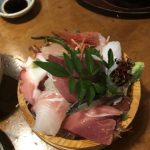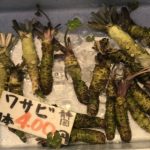Japan: Some Initial Food Thoughts

Sushi Tokyo Fish Market
Some of you who noted the absence of Tom's Food! these past few weeks may have been labouring under the impression that I was on holiday. As if! Those who follow me on social media will have known that L and I have been in Japan, researching frantically to keep these columns full for your edification and delight.
L had visited before nearly 30 years ago. She was a guest of the Japanese government, looking at Japanese education. My reasons for wanting to go were almost entirely food related. I knew virtually nothing about Japanese food. My spouse will not thank me for sushi or any type of raw fish. In the course of the last few years, I have noticed more and more top chefs experimenting with Japanese ingredients and techniques, and wanted to see for myself.
Cards on the table. I loved the place, the people and the food. L loved the place and the people. Thank you, my lovely, for agreeing to go along with this, all for my readers. As I anticipated, this trip has yielded a rich seam of material. We had market tours and cookery classes, and a trip round little bars in Tokyo's Golden Gai district, most of which sell food. We ate a few really authentic meals in spite of the language barrier. We missed out on our final day foodie tour because KLM cancelled our flight home the day before and offered no alternative, leaving us stranded in Tokyo. That's another story.
I haven't worked out a programme yet, but there will be a lot of Japanese based articles to come. Here, as a starter are a few random thoughts, in alphabetical order.
Breakfast
It's certainly not true to say that to eat well in Japan one should eat breakfast three times a day, but the buffets on offer at most of the hotels were stunning. Rice and fish and vegetables and pickled things. It's a very healthy diet. You can see why they have such a long life expectancy - and why you rarely see fat Japanese people (Sumo wrestlers excepted).
Beef
Well, congratulations, Japanese farmers, on perpetrating one of the great con tricks on an unsuspecting world. Kobe and Wagyu are the best known versions of this fraud, but there are local variations such as Tida. In Scotland we admire our beef with a little marbling of fat. With these abominations you are buying fat with a little marbling of beef, and that's reflected in its unpleasant taste. In an upmarket food store (think Harrods Food Hall) in Kyoto, Wagyu rib was on sale at £20 per 100g. That's £90 per lb. I've sampled it. Trust me, it ain't worth the money.
Dashi
This is the base stock for so many Japanese things. It's very simple to make with just two ingredients, kelp and bonito flakes (a type of tuna). It's also the base for miso soup - see below.
Fish
Don't go to Japan if you don't like fish.
Sushi is probably the best known Japanese food in this country, and you can get very good examples in many supermarkets. We're used to makizushi, the stuff rolled in seaweed using a bamboo mat. Nigiri sushi (see the photo above) is a chunk of fish, prawn, eel or whatever atop a pillow of rice. The skill in getting this to stick is incredible, but sushi chefs make it look so easy. There are other types, but we'll make makizushi in Tom Cooks! in a week or two.

Sashimi
Sashimi is simply raw fish with no rice. It will be expertly cut and the fish will be of the freshest.
Cooked fish. Don't worry, they do cook the stuff too, especially for breakfast, where grilled salmon and mackerel are very common.
Miso
We'll talk more abut miso in due course. It comes in paste form, in various colours with different strengths of flavour. You probably don't want to hear today about Aka, Shiro, Shinsu and Kouji. You'll encounter miso most commonly in soup form. It's served with every meal. Now, I like miso soup, I really do, but not all the time. Why not mix it up, guys?
Pickles
If anything stands still for long enough in Japan, it will be pickled or preserved. You could spend a year in the country and still not be able to recognise all of the bewildering range of available produce.
Rice
The staple food, the one that will fill you up even if you can't afford much to go with it. In Japan, short grain white rice is normally used. With most rices, if they go sticky, you haven't cooked them properly. Not so in Japan. It does make eating it with chopsticks easier.
An issue I had at the outset is that plain rice is boring. I sought advice from Mielko, our sushi teacher. Can I pour one of my main dishes on top of the rice? No, that would be considered childish. The approved way is to take a mouthful of rice then a mouthful of another dish, and eat both together. The good news is that it is permissible to add condiments to your rice. Add some soy, and some of the pickles which will accompany every meal, and you will have a happier bowl, while still maintaining etiquette.
The Japanese are such lovely people you just feel you want to go out of your way to avoid causing offence. So, no gesticulating with your chopsticks - lay them down horizontally please - and definitely no blowing your nose.
Soy
That's an article in its own right (coming soon). I suspect you may be surprised how much it contributes to the Japanese diet, Sadly, one such contribution is-
Tofu
I suppose there must be ways to render tofu edible. I just haven't encountered them yet.

Wasabi
Wasabi
I have in the past described this as a food of Satan, up (or down) there with English mustard. Then I saw a cook use a cocktail stick to apply the merest hint of a smear. Why didn't I think of that?
More oriental fun to come in the next few weeks.
Welcome back Tom.
Tofu in a Black Bean Sauce is the only way to make it edible 😏
Even with that, Gordon, the taste of cardboard will be coming through. But we had a great trip – many tales to follow.
Gordon it still doesn’t get rid of the texture 🤮
Ohh c’mon Tom true tofu eaters know it has to absorb the flavour around it. I challenge you to not love Ottolenghi’s black pepper tofu in his book Plenty. You just have to cut the tofu into really small pieces. Look forward to takes – welcome back.
Reminds me of Dr Samuel Johnson’s advice about cucumber. “It should be thinly sliced, well dressed with salt, pepper and vinegar – then thrown away as being unfit for human consumption.” Tofu ditto.
I made salt and pepper tofu for a vegan pal – rolled it in cornflour – fried in wok – tossed into another wok with v hot oil and shredded garlic, chilli and ginger was ok
Yeah, but for tofu you could read cardboard or rolled newspaper. You have a vegan pal? I admire your tolerance.
Totally with you on tofu, Tom. Reminds me of a comment I read about kale. Always remember to cook it with plenty of oil. It makes it easier to scrape into the bin! Glad the holiday was a great success.
Most enjoyable. Look forward to more. Every day a school day.
Tofu is a faff. I’ve enjoyed it (rarely) but it has zero flavour so seems to take an insane amount of work e.g. squeezed dry, coated, fried & soaked in a delicious (probably unhealthy) sauce. I don’t mind the texture when it’s cooked properly, somewhere between marshmallow & scallop but on every occasion I always think how much nicer would this be if they used
The last word of your comment has been tantalisingly omitted. Otherwise I’m with you 100%.
I’m inspired by (& jealous of) your trip. Loved Japanese food for years but struggled to cook anything interesting at home. Found many of the recipes to be very subtle until I discovered teppanyaki and some of their junk foods like yakisoba and okonomiyaki. Not very refined, I know but a step up from pie and chips?
Let me tell you, John, okonomyaki may be fast food, but it’s anything but junk. Absolutely delicious, and one of the few Japanese foods that Lesley really likes.